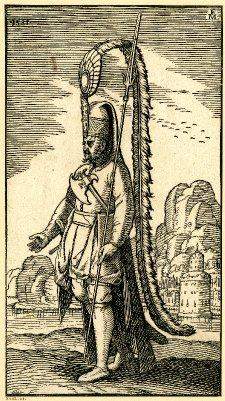Ottoman Soldiers from contemporary European Illustrations
Deß Weitberühmbten... Herrn Melchior Lorichs... Wolgerissene und Geschnittene Figuren
"Tyrkerværk" by Melchior Lorck in 1570-83 and published by Michael Hering (Hamburg, 1626)
Rest the cursor on a picture to see the caption, click for a larger image. Sources: Images
Text





































Melchior Lorck in Turkey 1555-1559
Melchior Lorck (AKA Lorichs, 1526/27- after 1588) is the first Danish artist whose life’s work is extensively documented in surviving records.
His connections to the Danish king Christian III and the German emporer Ferdinand I took him far afield in Europe and even to Turkey,
much farther than any other Danish artist of the time.
In 1555 Lorck was assigned to the embassy that the German king Ferdinand I (from 1556 Holy Roman Emperor) sent to the Sublime Porte,
the court of Sultan Suleiman the Magnificent in Constantinople (Istanbul).
Of the three and a half years that Lorck spent in the Turkish capital,
approximately one and a half were spent with the rest of the entourage in confinement at the caravanserai where the Germans had been installed.
In the periods of greater freedom however, he drew ancient and modern monuments of the city
as well as the customs and dresses of the various peoples gathered from all parts of the Ottoman Empire.
At the end of his sojourn, he must have been spending extensive time with the Turkish military,
as he was later able to portray a large number of different ranks and nationalities in the Ottoman army.
Lorck returned to Western Europe in the autumn of 1559.
Lorck’s journey resulted in 128 woodcuts, which he intended to publish as a book. However, he did not succeed in this. The Turkish Publication, as the work is entitled, did not come out until 1626, long after Lorck’s demise.
Text links to the images:
The swaggerer-sipahi
A bearded archer - solak
A soldier wearing a turban
A soldier walking to right
A Janissary walking
A rascal
An imperial bodyguard
A Janissary (Yeniceri)
A soldier holding a lance
A Turkish soldier
A bearded archer
A Janissary
A Cannoneer
A footsoldier running
A border soldier
Musketeer
A foot soldier
Turkish foot soldier
A soldier with lance and shield from the Morea
A soldier
A soldier wearing a helmet
A cavalry member
A foot soldier with pole-axe
A rider with a large double banner
A knight on horseback
A Spahi
A man on horseback holding a lance
A Turkish warrior
A running soldier
A Turkish archer
A bearded archer
A corpulent Turkish soldier
A governor - Beglerbeg
Spahi
The reckless soldier
An officer on horseback
A Janissary general on horseback
See also Illustrations of Ottoman Soldiers from Nicolas de Nicolay's Peregrinations faites en Turquie, 1576
Ottoman Military Illustrations from Hans Weigel's Habitus Praecipuorum Populorum (Trachtenbuch), 1577
Ottomans in De gli habiti antichi, e moderni di diverse parti del mondo libri due by Cesare Vecellio, 1590
Ottoman Soldiers from other European Illustrations
Ottoman Illustrations of Costume & Soldiers in the 15th to 19th Centuries
Index of Illustrations of Costume & Soldiers





































